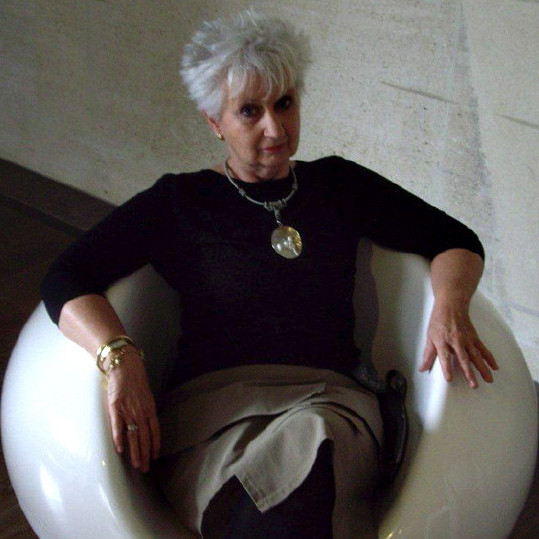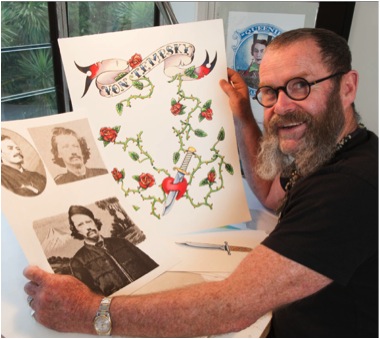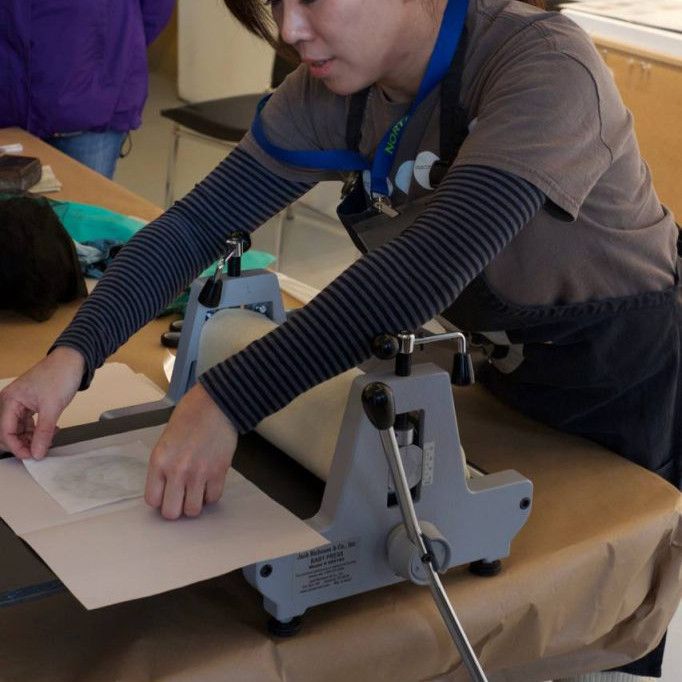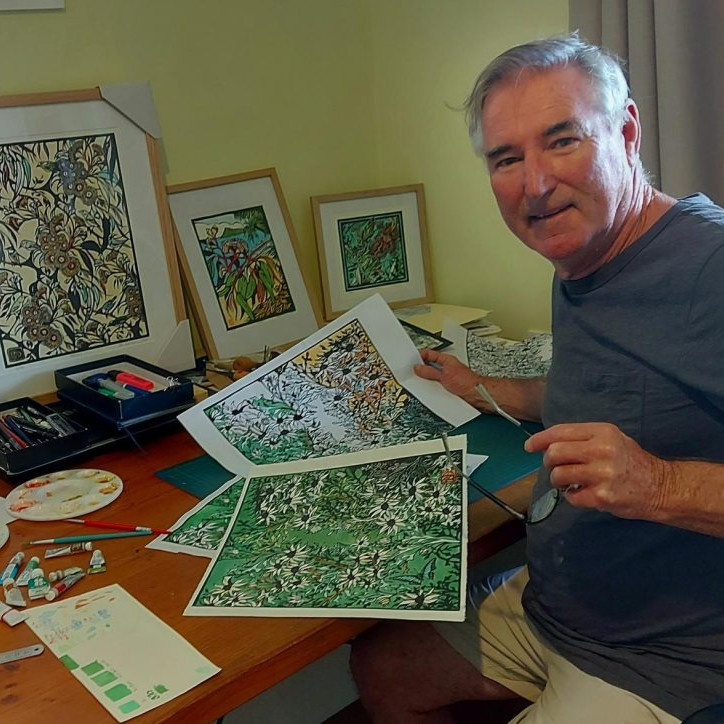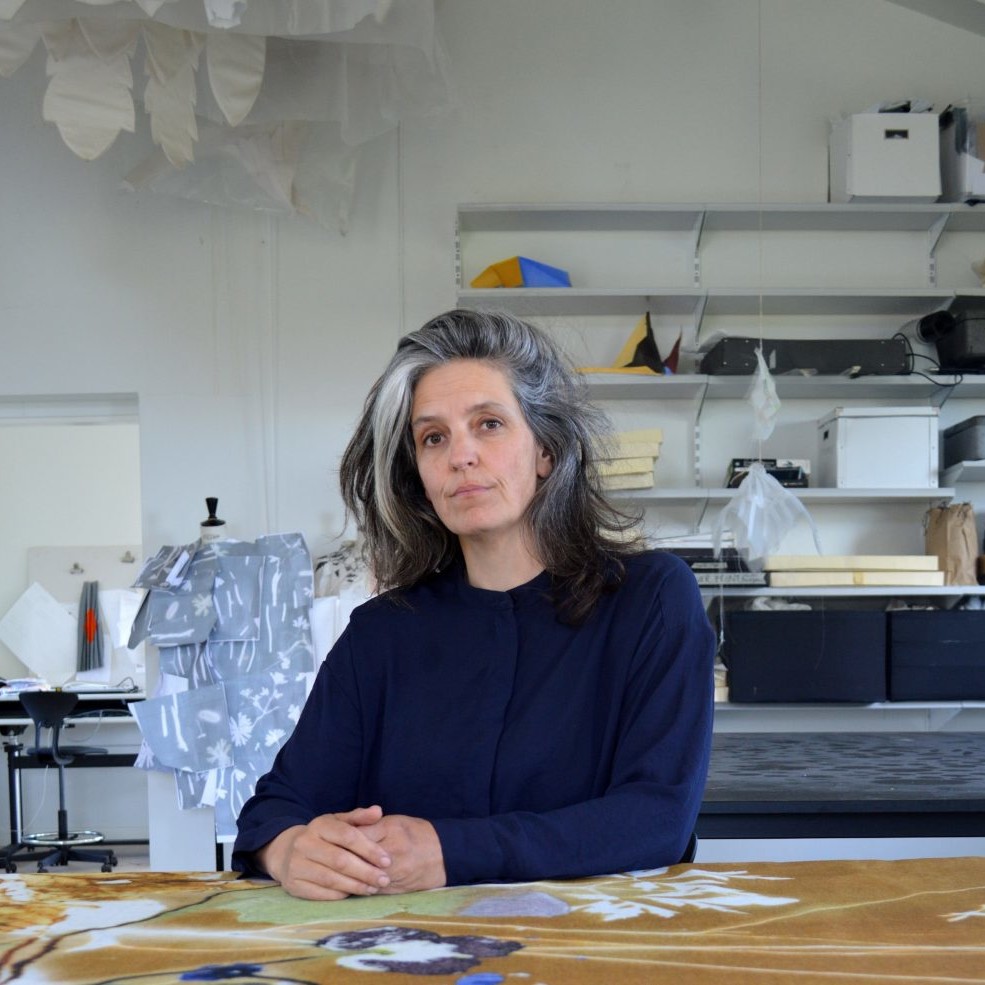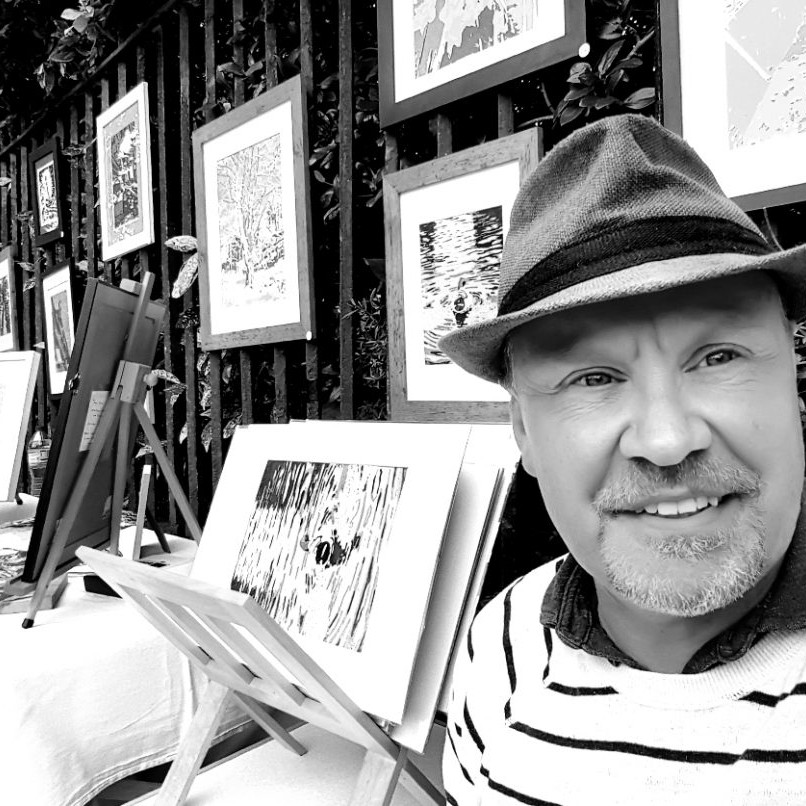Lester Hall Printmaker - Kerikeri, New Zealand
How important has your work with Maori and Pacific artefacts at the Auckland Institute and Museum been to your art?
Contact with actual artifacts was hugely important. As a person being brought up in any household we are set into the paradigm of our parents and schooling. As a white Kiwi I was taught that Maori were naughty savages and stone age… not in a really nasty sense, just that their culture had nothing to contribute because it was grass skirts and a language that was useless. Crashing into the incredible sift, woven garments I had in my hands to display at the museum let me know clearly that I would have been warm and comfortable, if in the chiefly class anyway. Being inside the museum walls also taught me that elegists were presumptive, arrogant and passive aggressive creating a self-righteous “knowing” of things that might not even be true. It also taught me that display had for decades been the first idea rather than understanding. This was the place where I truly understood I needed to stand apart from what anyone was telling me and ask the questions of myself and then search for answers.
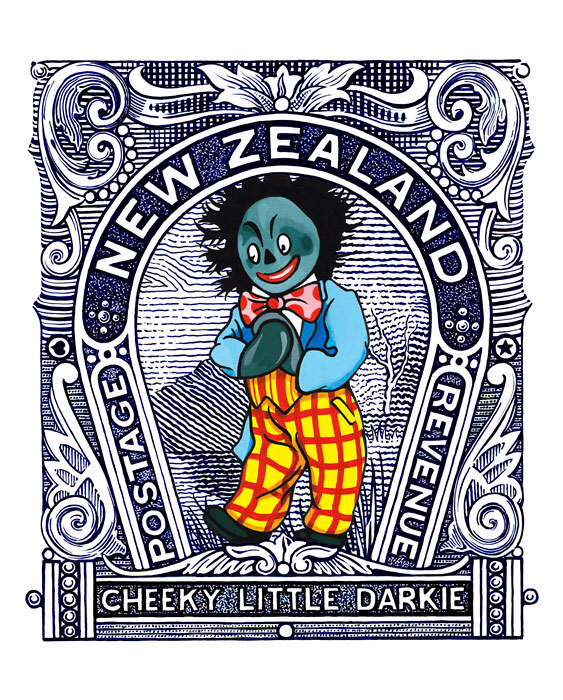
Cheeky Little Darkie
Do you think that your art has brought about improved racial relations in New Zealand?
In a small sense, yes, I absolutely work towards a “tipping point” of generated interest in the society as a whole.. I say my work is social commentary first, expressed through pop art… pop art… I am trying to make the conversation between Maori and Pakeha the most interesting and important for us all, because I think that is the truth.
Am I correct that your work initially (at first sight) is to amuse and only on deeper observation to question?
Yes. It is the lure and catch principle used in any hunting…. put this on your wall… look at it…. allow yourself to think and discuss with friends… feel a connection to your ideals and move forward through context, truth and conversation…
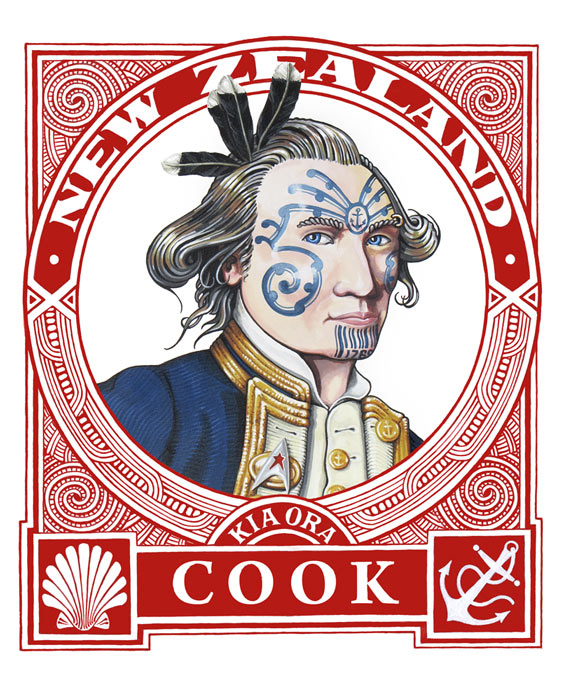
Kia Ora Cook
In your work you use actual accounts from historical journals, not history text books. Can you expand on this?
Sure, I prefer to read firsthand accounts. While I understand these people first hand writers are very affected by the paradigm of the time I try to look through the adjectives to the facts… “I saw someone eaten. It was a female slave. She was killed by her owner instantly having offended and was being eaten within two hours.” I think all historians are coloured by the times and politics they live in and espouse… so, after the facts have been interpreted by four or five generations of thought what is fact really?
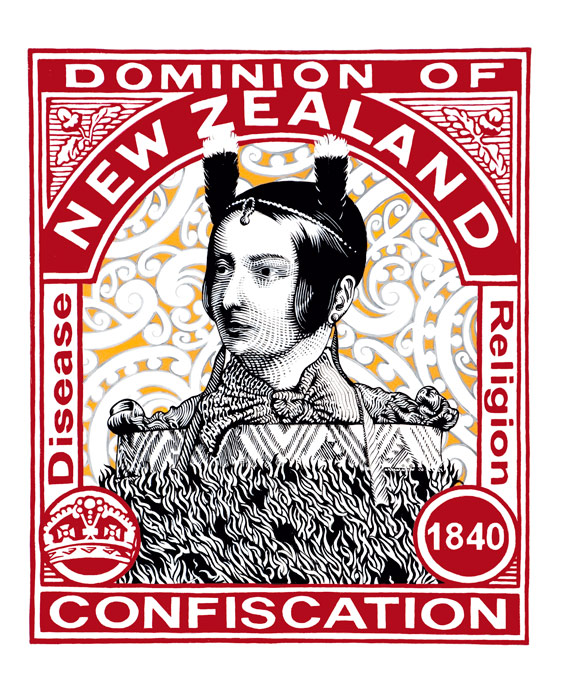
Wikitoria
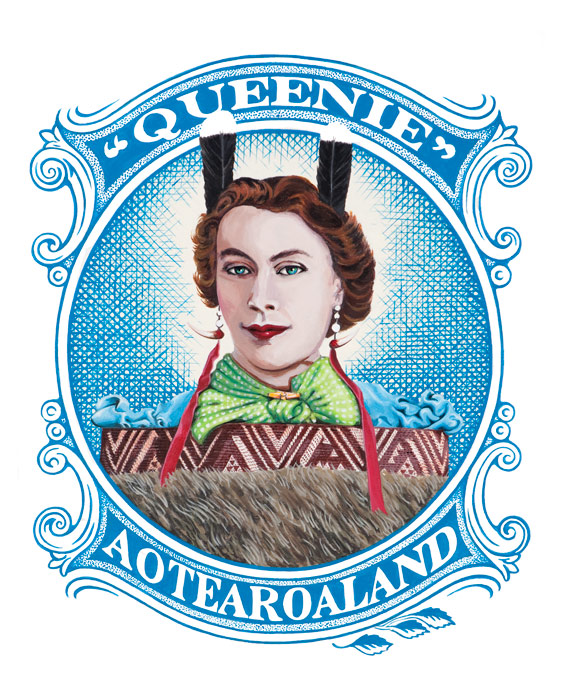
Queenie
Can you take Wikitoria, Climb Every Mountain and Tiki Mouse and discuss?
Okay, Wikatoria was drawn up as a balance statement against the romantic image of Elizabeth and “Queenie”; this is because they are both wearing the same clothes, suggesting the royal lineage and connection to power. I think the idea with this work is very basic and self-explanatory. It says to my audience, do not forget the fact this woman, Victoria, sat as the crown for almost all of the truly egregious ramifications the collision that Maori had with colonial effect. The image uses an old stamp style to create statement rather than possibility, Maori motifs with be clear about what part of the dominion and those few choice words for specific rather than cryptic inference.
Climb every Mountain is a far more specific piece for New Zealand. I say this because I used the Wikatoria stamp to create my “Abbo Queen” image…. the same things can be said about the Australian experience but far worse, right? In, Climb Every Mountain I am espousing a specific philosophical, not factual conversation with Maori and Pakeha alike as the assertion that only Maori are Tangatawhenua, or “the people of the land”. My stance is that all New Zealand citizens should enjoy this status as it is a spiritually based concept, not just a political label.
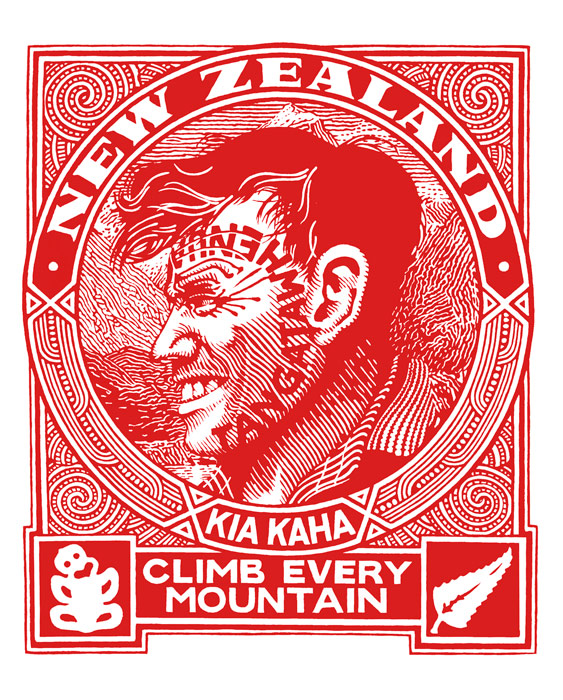
It addresses the conversation around difference and sameness and difference suggested as fact because of race. This conversation is specific to apartheid and who I am in my own land. I assert that I am Tangatawhenua, even though I am Pakeha. I chose Hillary on which to tattoo the title because he is the Pakeha icon of this nation… suggesting that if he is not Tangatawhenua then no Pakeha is. This also challenges Pakeha conservatives who would hate the suggestion or give it any importance or relevance. In approaching Maori with this statement, I am saying I am willing to discuss a spiritual and philosophical idea in depth meaning that I have to interpret their language and their history and their stance now. This conversation suggests I am invested deeply in my nation in a way that defines who we each are to each other… Not a “you did, you didn’t” tit for tat argument but a broadening of the mind and possibilities for society sense…. Also, in symbolism he was a mountaineer, the image is based on a photo that was used for a very well known and loved five dollar bill and the specific understanding I am talking about is the societal mountain I suggest is the most important for us to climb to achieve, trust, equality and forgiveness.
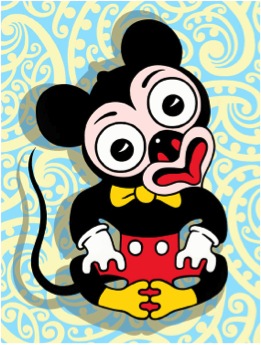
Tiki Mouse is another confrontation for Maori in the specific sense of appropriation and respect of culture. I utterly reject the notion that any cultural mores are sacrosanct from comment or even humour. Once one cannot laugh one is closed down and cowered. It is a celebration of a favourite New Zealand child’s toy, morphed through the styles of the Tiki and references another pop artist ubiquitous work on the subject. It is a beautiful work in its simplicity and direct love of what it is to be Kiwi in the design sense. No matter who a Kiwi is, once traveling the most obvious styles and imagery we can assert our origin with are Maori. This is represented by the kowhaiwhai patterns of the field or sky. Technically this is the first image that is totally computer generated… by that I mean that although I painted it, scanned it and placed it back in the computer I overlaid colour on every part of the image. This creates an exactness that is wonderful on this style of image, not so much for the portraiture in regard to historical facts… they are very important but all must be taken with some salt… I encourage an investigation about history as a narrative, as characters, as myths. allow some second guessing, learn to love the stories and give or take truth so the subject has some life in it. The Museum taught me that historical fact is open to interpretation often and that cultural paradigms can be so powerful that truth can in fact be different to two minds… So, look for the similarities and celebrate those. Look for the sameness and celebrate the differences but most of all realize it is us, the citizens and not the historians and politicians and activists and lobbyists that make up day to day life. Beware of those tails wagging the dogs…
Finally a specific word about text. The stamp styles and the sports card and book covers I am about to do allow text….. wonderful for getting a non-cryptic message across. While I say non cryptic I do not suggest they are obvious. To be obvious these artworks require the audience not to be ignorant……. so they encourage learning curves, something that all societies need.
Do you provide an explanation of the background with each print?
Yes, every print comes with a narrative sticker for the back when framed. I am not interested in what commentators think of my art… these images are about my specific thoughts and ideas. I have worked too long and hard to leave what they mean in the hands of other minds.
Your prints are widely available throughout New Zealand; do you think the average tourist fully understands what they are buying?
I think the ones that buy probably do for the most part because of the specific descriptions. I also have a very in depth and growing website explaining my thoughts in depth.
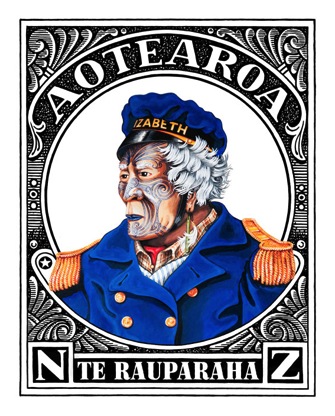
Te Rauparaha
As well as single prints you sell your work in smaller sizes to be like a Postage series set, can you expand on this aspect of your work?
Many people have a collecting gene… we love to see things in a group… they are stamp style and so suit the line up of image. This also allows more of a story to be told through the use of multiple images.

Can you explain where you do your printing?
I print every work in my studio.
Can you expand on the actual printing technique you use?
I use a seriously wonderful high end ink jet printer and chromium inks and rag paper. I do this because it gives me power and creative freedoms that simply cannot be achieved off site.
Do you do specific new work for exhibitions what format does it take?
New exhibitions are usually formatted around several new works, an original or two and woven pieces. the woven pieces are made by an expert in Maori Neolithic tech and require two version of the image to be cut up and woven back together. I also do odd prints for exhibitions. These may be “faulty” or “double printed” images, stamp out like real stamps reflecting the philatelist’s love of the mistake. I also allow a lot of play with framing for shows.
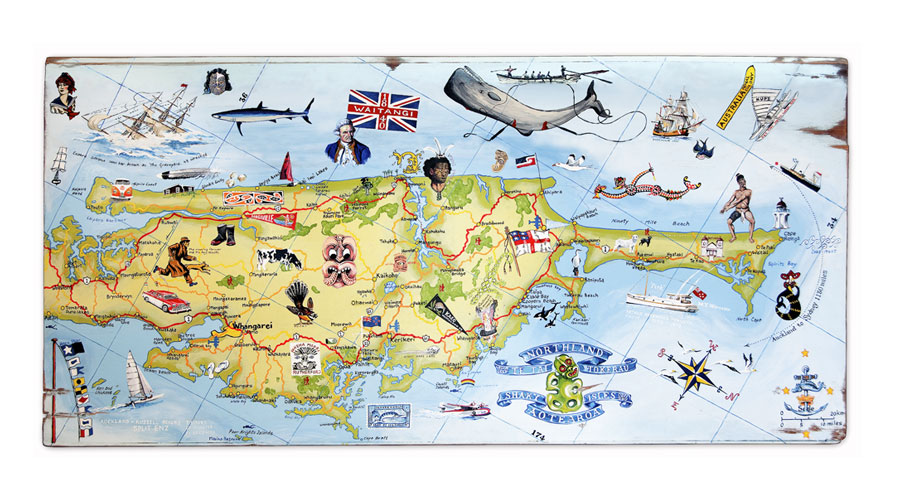
Te Tai Tokerau Tiki Ttour
What are you currently working on?
Currently I am creating a series of Pakeha or white fighters of Maori in the wars. It is being produced in the manner of sports cards and they as a group with be titled the Pakeha Dream Team. I am doing this to refute the idea that Maori have some specific, exclusionary hold on the title of warrior as they are inclined to do in NZ… These works also suggest it is important to retain good understanding of the men and women who created the nation if they are politically correct this season or not. I detest the myopic viewpoints that are created by lobby groups and those who get into institutional power such as museums. This series will be followed by the Maori Dream Team too of course…
Contact details
www.lesterhall.com
Lester Hall, Kerikeri, New Zealand
Interview by Deborah Blakeley, July, 2013
Think a colleague or friend could benefit from this interview?
Knowledge is one of the biggest assets in any business. So why not forward this on to your friends and colleagues so they too can start taking advantage of the insightful information the artist has given?
Other artists you may be interested in:

